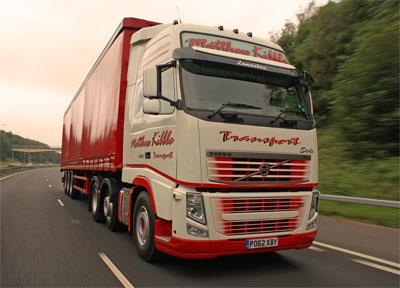
Backload rates are so bad that some operators are wondering if they’re worth taking.
Is the era of backloads coming to an end? It certainly sounds like it for some operators, judging by comments MT has heard recently. The issue, of course, is that the rates being handed out for many backloads simply aren’t high enough for the job to be worth taking.
It’s a long-standing problem voiced most recently by Matthew Kibble, MD of Lancashire-based Matthew Kibble Transport, who told sister title Commercial Motor last month that it was not unusual to be offered rates as low as £1.10/mile (CM 20 September).
Given fuel costs of about 65p/mile, said Kibble, a minimum of £1.60-£1.70 is needed – and the upshot is that his firm frequently returns home empty when making regular trips to Scotland.
Worth their weight?
Kibble is not the only one to find that backloads aren’t always worth taking on. Steve Frowen, director of Coventry-based Steve Frowen Transport, who makes frequent trips to France, Belgium and the Netherlands, said he only gets backloads from the Continent about 5% of the time, and that the rates he gets are only sometimes worth it.
More recently, the RHA has pitched into the debate, with director of policy Jack Semple urging those handing out backloads to pay a sustainable rate, and encouraging vehicle operators to turn the work down if they can’t get a decent reward (MT 4 October).
Poor backload rates aren’t just about profit, however. As Kibble underlined, they also raise issues about vehicle fill and scheduling.
“It bugs me when I see so much in the press about companies doing fewer miles and firms bragging about their fill rates, and then you find out it’s at an unsustainable fee,” he said.
“If the rates aren’t worthwhile, you’re often better off bringing the vehicle back and giving it a fresh outbound load instead,” said Kibble.
The delays that can be inherent in backloads can also be a problem, added Frowen. For example, when a vehicle operator seeks to make a drop on a Friday afternoon only to be told the load won’t be accepted until Monday morning.
Such delays, which happen often, leave the vehicle operator with the triple headache of storing the goods, repeating the delivery, and then trying to persuade the customer that a bigger bill is going to be necessary.
Environmental impact
There is also a question mark over the environmental benefits of backloads as clearly any significant deviation on a return leg to collect a load and any subsequent detour to deliver it will both mean higher fuel consumption – as will running vehicles back heavily laden, rather than empty.
Simon Chapman, chief economist at the FTA, agreed this can be a fine balance but stressed that if a backload saves an entire journey, it is likely to be worth the additional mileage. “One of the principal drivers for contracting out is that the haulier is able to use the vehicle for outhaul and backhaul. Hauliers running out full and back empty doesn’t make a lot of commercial sense,” he said.
The extra mileage involved in backloads is the whole essence of the problem, according to Lyall Cresswell, MD of online load trading firm Transport Exchange Group.
“It depends on how much the job fits in with what you are doing. If you’re already backed up to a DC, that’s straightforward, subject to the destination. But there’s a big difference between that and saying you’re going to divert 30 miles to pick something up,” he said.
Clearly, vehicle operators need to ensure they know their costs and insist on a rate that delivers a profit – whether it is fronthaul or backhaul work. RHA has calculated that for a typical 44-tonner averaging 8mpg, the costs (including overheads) will be in the region of £2.01/mile at 70,000 miles a year and £1.87/mile at 80,000 miles a year.
Semple pointed out that jobs with low mileage but high waiting time may not be based on a pence-per-mile rate at all; while fully laden vehicles or those operating on congested or hilly roads will not be achieving 8mpg.
Sadly, with the boot often on the wrong foot when it comes to rates, knowing your costs is only half the problem. “There is lots of pressure on the haulage industry in terms of demand and rates and a lot of firms are feeling intense pressure,” said Semple.
“Some low haulage rates are coming from large companies, either directly or indirectly, and it’s important [for firms] to be on top of their costs and to take a stand and try and educate their customers.”
Unfortunately, some customers seem happy to force hauliers into desperate measures, Semple added. “The reality is that there are people in the market looking desperately around for any work they can get.
“There are concerns that some jobs are being issued at rates that can’t be done legally, or with service times that can’t be achieved in the scope of the law. It’s something we’re trying to take forward as best we can.”
Pendulum swing
Ultimately, many expect the pendulum to swing the other way at some point, as a pick up in manufacturing and economic activity – combined with fewer service providers – drives rates for frontloads and backloads up.
Until then, however, canny operators will continue to question the sense of taking loads that make no money, and prevent them from taking on more lucrative business elsewhere.














